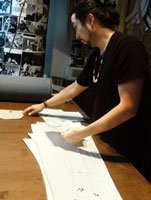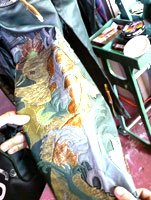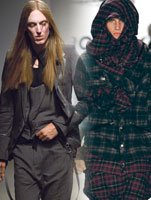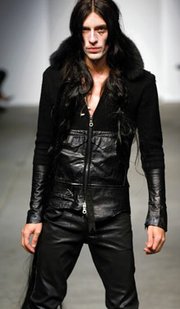L.A.'s Menswear Designers Take Risks as Others Play It Safe
Even in the best of times, menswear is rarely on the cutting edge of fashion. Womenswear—with its dramatic trends, glossy magazines and voracious consumers—tends to unabashedly hog the spotlight. So, it is a bit surprising to find that as fashion in general is hunkering down for tough times ahead, a crop of Los Angeles–based menswear designers is offering unique services and pushing the design envelope.
With his Spring 2009 runway show, which got editors and buyers buzzing, designer Michel Berandi could be the poster boy for the new breed of menswear. Dark and lovely, his menswear designs aren’t what the average guy would wear (slim overalls cut from suiting with matching blazers, skinny sweaters with leather sleeves and fur collars, goat-hair jackets, and liquid leggings), but they are at the forefront of menswear’s move away from the middle.
Berandi, who launched his eponymous brand three years ago and sells it at Maxfield and other exclusive retailers, takes a philosophical view toward menswear. On the one hand, he said, buyers are increasingly cautious with their buys, and his investors are nervous about his “too crazy” designs. On the other hand, as a designer, he thinks fashion should be theatrical and fun. In the end, Berandi split the difference by launching MB999 for Spring 2009, a diffusion line that shares Berandi’s beautifully macabre aesthetic but is mitigated with more price-conscious fabrications and more-wearable designs. “It’s a paradox. Buyers want new and extravagant, but they need to sell and make money. So, we toned down the design a bit to make it more attractive to more people, but it still gets a little crazy. In the end, I sell a lot of T-shirts,” he said.
Designer Peter James Lee built his brand, Cassette, on wearable, tailored pieces with just the right amount of edge, making it a favorite of buyers. With his street credibility and premium-denim background, Cassette’s first seasons leaned heavily on denim. Recent seasons have pushed Lee into a more mature direction, with a heavier focus on traditional tailoring, high-end fabrications and more-forward designs. In September, Lee took his brand to New York to participate in Fashion Week, where his seriously shrunken short suits for men, tuxedo shirts with a skate vibe and super-slim puffer vests with motorcycle-jacket styling were well received.
“In this reality, meaning a full stop at retail, we have to plan our next move,” Lee said, speaking from his studio in Los Angeles’ Little Tokyo. “Do we continue on the same track, or do we try to be creative?” One way Lee is being creative is by applying his tailoring focus to his other love, denim. For $650, denimheads can visit Lee at his studio and be fitted for a pair of handmade bespoke jeans. “They can have exactly what they want—they can customize their fit, choose the denim and the wash. We will build them a pair of totally custom jeans, have a fitting to perfect the garment and keep their pattern on file,” Lee said. Finished bespoke jeans can be produced at the Cassette studio and delivered within a week. Lee acknowledges that the customer base for this sort of service is slim, but the idea is to help elevate and rebrand Cassette. “We’re digging deeper now and looking for ways to stand out.”
Antonio Barragan, a former buyer and store manager for H. Lorenzo, is taking custom-made menswear a step further. Out of his studio in Los Angeles, Barragan whips up theatrical one-of-a-kind leather jackets, leather pants, denim, wool blazers, cashmere sweaters and woven shirts—all intricately embellished or laden with hand-sewn layers of python, snake, lizard, frog and sanded stingray skin cut into tattoo-inspired designs. Everything is handmade with sterling-silver hardware, and upscale touches, such as vintage Hermegrave;s scarves used for pocket lining, abound. Produced under Barragan’s Demon Riff label, the pieces are over-the-top rocker sexy and priced to match. Wholesaling for $800 to upwards of $1,200, Barragan’s pieces aren’t subtle, but they satisfy a small but distinct need in the market, he said. “I’m starting out by selling to a couple stores overseas. They were asking me for candy. There is a guy who wants luxury but with a serious attitude.” He is also beginning to add a few pieces that can be produced in larger numbers.
Barragan said that while not every menswear designer is going as far out on a limb, there are plenty rebelling against what they perceive to be creative stagnation in the market. “Other more established brands are moving in a safer direction,” he said. “Someone has to step in and fill that void. That’s what we’re trying to do. We have that youthful sense of adventure and we don’t want to play it safe.”
Artist/designer Brett Westfall of Unholy Matrimony has been pushing the envelope on several fronts. Earlier this year, he collaborated with Comme des Garccedil;ons to launch the brand’s guerrilla store in downtown Los Angeles, and in July, eight of Westfall’s paint-splattered pieces were shown on the Comme des Garccedil;ons runway in Paris. Westfall has also collaborated with Los Angeles designer Joel Knoernschild of KZO for several seasons, turning out pieces such as flannel shirts with double-layered sleeves that wholesale for $160. His own collection features wearable pieces gone wild. T-shirts spawn pockets and patches and screen prints. Jeans are cut into shorts and laden with cargo-style pockets. Woven hoodies get kangaroo pockets and are covered in Westfall’s drawings of stormy seas and whales tossing spears. “Risks do not apply when creating any garment or artwork. Creative freedom has more importance in Unholy Matrimony,” Westfall said. “But the probable benefits and pitfalls [of risk] as an end result would be being able to pay your bills or not.”
Knoernschild, who showed his Spring 2009 collection (including Westfall’s flannel shirt) during Gen Art’s Fresh Faces showcase, said more-directional pieces such as Westfall’s and a jacket and camera bag inspired by the lives of working photographers allow designers to tell the story of their overall collection. “Not everything can be fun and cool and experimental, but you have to allow yourself the luxury of at least a few pieces that are different and avant-garde,” he said.
James Hammonds, the menswear buyer for the American Rag chain of boutiques, said the economy and shoppers’ modified buying are informing his interest in directional menswear. “Right now, we’re doing best with ’me too’ styles—styles that are popular and easy to understand and not too expensive—and with really funky, forward stuff. If we hit it just right, if we nail it perfectly, we will sell out of the crazy stuff very quickly. Of course, we’ve had plenty of misses,” Hammonds said. More-forward and challenging menswear buys are eating up 10 percent to 20 percent of his total buys, Hammonds said. “There has been a huge fallout in the middle. Shoppers want either real quality high-end brands and pure fashion or the opening–price point classics. The mid-range contemporary sector is really hurting.”
Randy Brewer, general manager of the Villains and more upscale Villains Vault boutiques in San Francisco, said he is always looking for innovation in design, whether it be in subtle touches or in-your-face looks. “Thirty percent of our stock [in Villains Vault] is unique or has a narrow appeal. Misses happen a lot, but we’ve built a customer base that comes to us for the more forward fashions, so we give it a shot,” Brewer said. “It’s a risk we have to take.”
Ilan Bitton, owner of Legion, a menswear boutique in Los Angeles’ Larchmont neighborhood, said he often feels like a risk-taker by virtue of the fact that menswear-only shops are such a rarity here. “Men in Los Angeles are just getting used to the idea of a menswear boutique. I have to be careful not to scare them away with fashion that is too forward,” he joked. “My shoppers can be conservative, but I have to buy a few pieces of pure fashion just to make the store pop and to get them to see beyond the basics. Most people don’t get it immediately, but they can at least appreciate the effort and then move on from there.”



























